Mac Pro (Late 2013): installing or replacing memory
Find out how to correctly remove and install memory in your Mac Pro (Late 2013).
Your Mac Pro (Late 2013) has four upgradeable memory slots. These support up to 64 GB of memory when all four slots are full using 1866 MHz DDR3 ECC RDIMMs.
Before upgrading memory
Make sure the memory you're planning to use is compatible with your computer. The Mac Pro supports both unbuffered UDIMMs and registered RDIMMs, but it is important not to mix these types of memory. All DIMMS must be 240 pin DIMMs and support voltages of 1.5V or 1.35V. DIMMs that are not installed correctly or do not meet the system requirements may affect system performance or may not be recognised. DIMMs with heat sinks are not supported and may damage the DIMM mechanism.
Apple recommends using Apple-approved DIMMs. You shouldn't use DIMMs from older Mac Pro computers in your new Mac Pro. You can purchase Apple-branded memory by visiting an Apple Retail store or Apple Authorised Reseller.
Refer to Mac Pro (Late 2013) Memory Specifications for additional information.
Removing and installing memory
Part 1: Remove the enclosure
Before opening your Mac Pro, shut it down by choosing Shut Down from the Apple () menu.
If the computer is warm to the touch, wait approximately 5-10 minutes for the computer to cool down.
Touch the metal enclosure on the outside of the Mac Pro to discharge any static electricity.
Important: Always discharge static before touching parts or installing components inside your Mac Pro. To avoid generating static, don't move around the room until you've finished installing the memory and have slid the enclosure back onto the computer.
Unplug all of the cables and the power cord from your Mac Pro. Do not attempt to install memory while it's plugged in.
Slide the enclosure latch to the right to unlock the enclosure.

Lift the enclosure straight up and off the computer. Carefully set it aside.
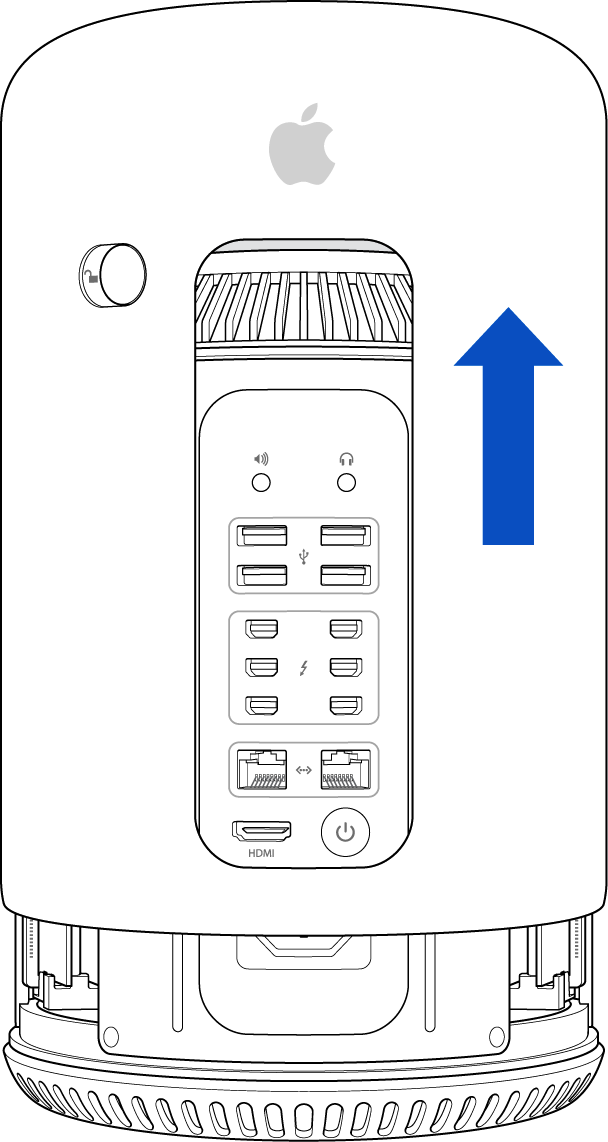
The DIMM slots will now be visible from the left- and right-hand sides of the I/O panel.
Part 2: Removing existing DIMMs
Your Mac Pro came with DIMMs already installed in some or all of the DIMM slots. Before upgrading the memory, you may need to remove some or all of the DIMMs. Refer to the table below to determine how your Mac Pro is configured and to determine which DIMMs you'll need to remove and replace to maintain a recommended memory configuration. See the numbered steps following the table to locate specific DIMM slots.
Important: All DIMMs are 1866 MHz DDR3 ECC. Do not mix UDIMMs and RDIMMs.
Total memory | DIMM Slot 1 | DIMM Slot 2 | DIMM Slot 3 | DIMM Slot 4 |
|---|---|---|---|---|
12 GB | 4 GB ECC UDIMM | 4 GB ECC UDIMM | 4 GB ECC UDIMM |
|
16 GB | 4 GB ECC UDIMM | 4 GB ECC UDIMM | 4 GB ECC UDIMM | 4 GB ECC UDIMM |
32GB | 8 GB ECC UDIMM | 8 GB ECC UDIMM | 8 GB ECC UDIMM | 8 GB ECC UDIMM |
64 GB | 16 GB ECC RDIMM | 16 GB ECC RDIMM | 16 GB ECC RDIMM | 16 GB ECC RDIMM |
Remove DIMMs with these steps.
There are a total of four DIMM slots. Two are located to the left and two are located to the right of the Mac Pro I/O panel.
Access the DIMM slots by using the RAM bay release lever (identified by a white triangle (A) at the top of each DIMM back). Push and lift upwards on the lever. The lever should move backwards and up, releasing the DIMM slots to swing out and making them easily accessible. Do not use excessive force on the release lever as you can risk damaging the latch.
Locate the DIMM(s) you want to remove. The slots are numbered 1-4 (B). Using your thumb and index finger from each hand, grip the DIMM gently at each end and remove the DIMM carefully by pulling it straight out of the DIMM slot. Do not twist or force the DIMM out of the socket, or damage may occur. Remove the outer DIMMs first to make the inner DIMMs easier to remove.
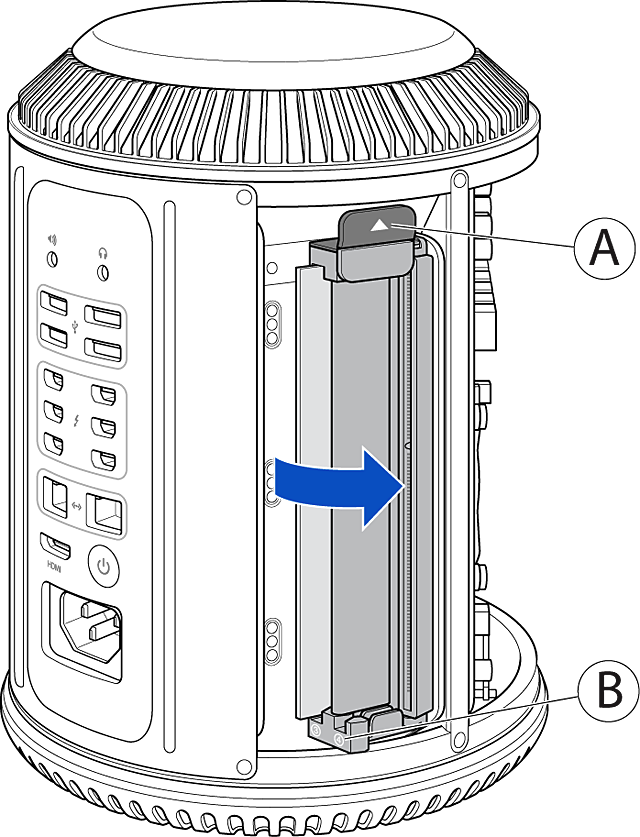
Place the removed DIMMs into an ESD (electrostatic discharge) protective bag.
Part 3: Installing DIMMs
Each DIMM (F) has a notch (E) that must line up with the key (D) inside the DIMM slot (C). Note: The key/notch position is different on each side of the computer.

Locate the DIMM slot closest to the interior of the computer and confirm that no DIMM is there.
If available, use canned air to blow dust and other contaminants out of the DIMM slot. Note: Keep the can vertical to avoid spraying propellants onto the DIMM slots.
Hold the DIMM ends gently and insert it into the slot. Ensure horizontal alignment of the DIMM prior to applying any force.
Insert the DIMM at the angle determined by the open DIMM mechanism.
Insert gently until the bottom edge of the DIMM is touching the gold contacts, then apply more force to seat the DIMM fully.
Do NOT force the DIMM. If the DIMM doesn't insert, verify that the key (D) and notch (E) are aligned.
Do NOT rock the DIMM into the seated position.
Do NOT insert DIMMs while the DIMM mechanism is in the locked position.
Do NOT bend or twist the DIMM during insertion.
Press the RAM bay back into place after installing all DIMMs.
Part 4: Reinstall the enclosure
Lower the enclosure over the Mac Pro, being careful not to touch any of the circuit boards.
You may need to push down gently on the enclosure in order for it to seat fully.
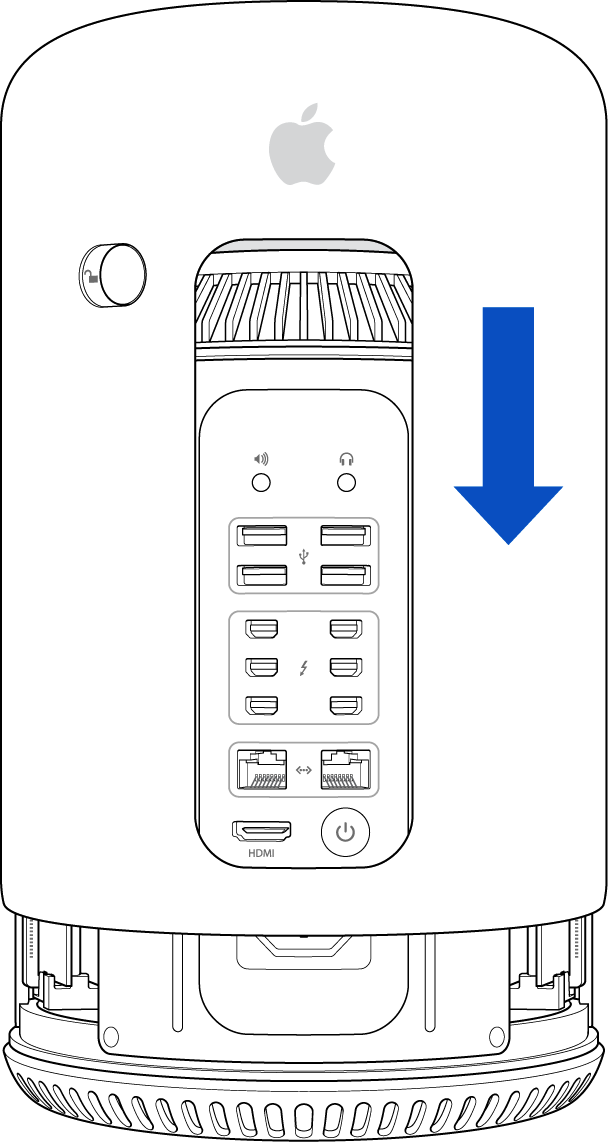
When the enclosure is fully seated, slide the enclosure latch to the left to lock it.
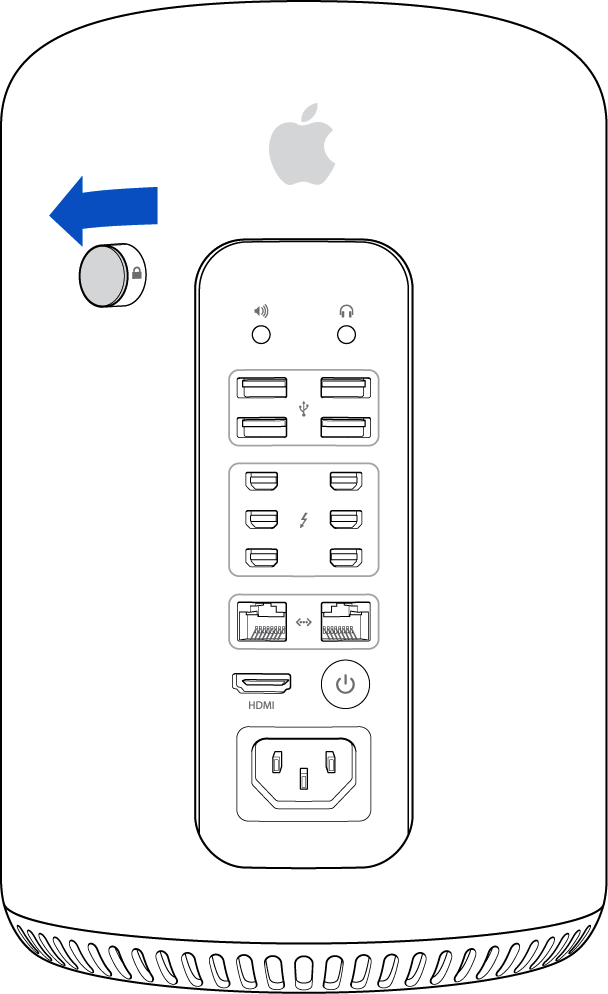
If the enclosure latch does not move all the way to the left, verify that the enclosure is installed correctly and seated fully, then try again.
You are now ready to connect a power cord, display and other peripherals. Turn on your Mac Pro and verify that your system is operating correctly.
If your Mac doesn't start up correctly after installing memory, you may have mixed UDIMMs and RDIMMs. Mixing UDIMMs and RDIMMs will result in a memory error tone when turning on your computer. Check the memory requirements for your Mac.
If your Mac beeps during startup
If your computer detects an issue with its memory (RAM), you may hear the following tones.
One beep every five seconds
Your Mac isn't detecting any memory (RAM). If you've added or replaced memory recently, make sure it's installed correctly.
Three beeps, then a five-second pause, repeating
The memory in your Mac didn't pass an integrity check. If you've added or replaced memory, make sure it's installed correctly.
Memory verification
To ensure you've installed the memory correctly and that it's been recognised by the Mac Pro, follow these steps.
From the Apple () menu, choose About this Mac.
Click More Info. A window with general information about your Mac will appear.

Click the System Report button to bring up more detailed information on the memory installed in the computer.
Click the Memory tab.
Check the memory you've installed is listed and appears as expected. In the image below, the DIMMs are annotated (DIMM1, DIMM2, DIMM3, DIMM4) so you can identify the corresponding DIMMs which are numbered 1, 2, 3 and 4 at the bottom of the DIMM mechanism.
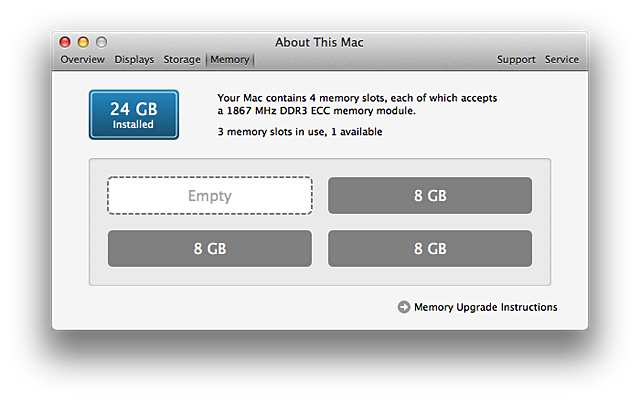
If one or more memory slots you've installed memory in are listed as empty, shut down your computer and follow the steps again to verify that the memory has been installed correctly. Refer to Mac Pro (Late 2013) Memory Specifications to confirm the memory meets the requirements for your Mac Pro.
If you're continuing to experience issues with memory you've installed, contact Apple Support for information about the support options available to you.